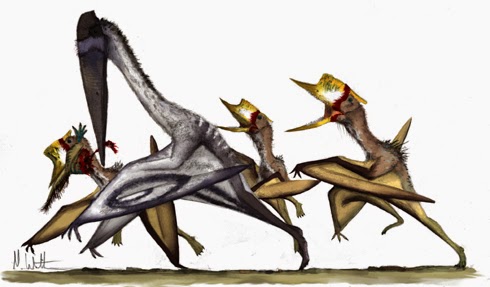 |
| Figure 1: A couple of anachronistic friends. A Darwinopterus- a pterosaur from the Jurassic, and a European robin- a dinosaur from the Quaternary. Artist: Mark Witton. |
New discoveries are constantly expanding our knowledge of tetrapod flight. Just a few weeks ago, an incredible new winged dinosaur was discovered. Yi was a scansoriopterygid that lived in China around 160 million years ago. Each of its hands had an extremely long third finger as well as a strange long styliform that grew from the wrist. These may have supported a wing membrane, as evidenced by fossilised membranous tissue found in the wrist area. While Yi may not have been capable of true flight, it is still an interesting example of how maniraptoran dinosaurs tried out more than just one wing design (Padian, 2015). Some classify scansoriopterygids as basal avialans (Martyniuk, 2012). Others classify them as more primitive non-avialan maniraptorans (Paul, 2010).
 |
| Figure 2: Yi, a membrane winged scansoriopterygid. While it may not have been capable of true flight, perhaps it could flutter. Artist: Emily Willoughby. |
Research has also helped destroy old prejudices about pterosaurs and bats. Once thought to be poor flyers, pterosaurs are now known to have actually been the most effective flying animals ever, with amazingly efficient wings and launching capabilities (Witton, 2013). Bats too, often overshadowed by birds, have been shown to be quite successful and diverse, indeed some of the most diverse of all mammals (Altringham, 2011).
 |
| Figure 3: Representatives of each flying tetrapod group flying together with an airplane- a machine invented by some upright apes who wanted to fly too. Artist: Matteo Bachin. |
What does the future hold? Will any other tetrapod group ever evolve flight many millions of years from now? Who knows. Only time will tell.
References
Altringham, J. D. (2011). Bats: From Evolution to Conservation. Oxford University Press: Oxford.
Martyniuk, M. P. (2012). A Field Guide to Mesozoic Birds and Other Winged Dinosaurs. Pan Aves: Vernon, New Jersey.
Padian, K. (2015). Dinosaur up in the air. Nature. 521 (7550), pp. 40-41.
Paul, G. S. (2010). Dinosaurs: A Field Guide. A & C Black Publishers Ltd: London.
Witton, M. P. (2013). Pterosaurs. Princeton University Press: Princeton, New Jersey.
Image sources
Figure 1: Accessed May 26, 2015, from: https://blogger.googleusercontent.com/img/b/R29vZ2xl/AVvXsEhVXAWWt6i-CAOhAYeIKbrpa3Ei9ROTbEWGg1LxKfhN5j8YXUWFiKYanExv6iB8rc1BVAq9Mw2wsICHsbVLe-Mt2mydTLnm4dp7sfgZwkc9RD8UP-WmkL4lHKirrF47pJq4gC7CEtGJgpw/s1600/Darwinopterus+and+Robin+Witton.png
Figure 2: Accessed May 26, 2015, from: http://upload.wikimedia.org/wikipedia/commons/5/56/Yi_qi_restoration.jpg
Figure 3: Accessed May 26, 2015, from: http://pterosauria.weebly.com/uploads/2/2/0/7/2207195/189247.jpg?595
































